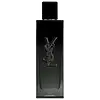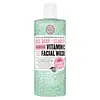What's inside
What's inside
 Key Ingredients
Key Ingredients

No key ingredients
 Benefits
Benefits

No benefits
 Concerns
Concerns

 Ingredients Side-by-side
Ingredients Side-by-side

Alcohol
AntimicrobialParfum
MaskingWater
Skin ConditioningLimonene
PerfumingLinalool
PerfumingCoumarin
PerfumingCitronellol
PerfumingButyl Methoxydibenzoylmethane
UV AbsorberAlpha-Isomethyl Ionone
PerfumingCitral
PerfumingMethyl Anthranilate
MaskingGeraniol
PerfumingCinnamal
PerfumingIsoeugenol
PerfumingFarnesol
PerfumingCI 60730
Cosmetic ColorantCI 60725
Cosmetic ColorantCI 14700
Cosmetic ColorantCI 19140
Cosmetic ColorantCI 42090
Cosmetic ColorantWater
Skin ConditioningSodium Lauroyl Methyl Isethionate
CleansingGlycerin
HumectantAcrylates Copolymer
PEG-7 Glyceryl Cocoate
EmulsifyingCocamidopropyl Betaine
CleansingCoco-Glucoside
CleansingGlyceryl Oleate
EmollientLauric Acid
CleansingSodium Methyl Isethionate
EmulsifyingSynthetic Wax
AbrasiveDipropylene Glycol
HumectantParfum
MaskingSodium Hydroxide
BufferingSodium Chloride
MaskingTetrasodium EDTA
Zinc Laurate
Limonene
PerfumingAscorbyl Glucoside
AntioxidantPolyquaternium-7
Benzophenone-4
UV AbsorberAmyl Cinnamal
PerfumingButylphenyl Methylpropional
PerfumingCitric Acid
BufferingLinalool
PerfumingMagnesium Nitrate
Citral
PerfumingCitrus Junos Fruit Extract
Skin ConditioningAlpha-Isomethyl Ionone
PerfumingLecithin
EmollientAscorbyl Palmitate
AntioxidantMethylchloroisothiazolinone
PreservativeMagnesium Chloride
Tocopherol
AntioxidantHydrogenated Palm Glycerides Citrate
EmollientMethylisothiazolinone
PreservativeMaltodextrin
AbsorbentCI 73360
Cosmetic ColorantCI 77891
Cosmetic ColorantCI 42090
Cosmetic ColorantWater, Sodium Lauroyl Methyl Isethionate, Glycerin, Acrylates Copolymer, PEG-7 Glyceryl Cocoate, Cocamidopropyl Betaine, Coco-Glucoside, Glyceryl Oleate, Lauric Acid, Sodium Methyl Isethionate, Synthetic Wax, Dipropylene Glycol, Parfum, Sodium Hydroxide, Sodium Chloride, Tetrasodium EDTA, Zinc Laurate, Limonene, Ascorbyl Glucoside, Polyquaternium-7, Benzophenone-4, Amyl Cinnamal, Butylphenyl Methylpropional, Citric Acid, Linalool, Magnesium Nitrate, Citral, Citrus Junos Fruit Extract, Alpha-Isomethyl Ionone, Lecithin, Ascorbyl Palmitate, Methylchloroisothiazolinone, Magnesium Chloride, Tocopherol, Hydrogenated Palm Glycerides Citrate, Methylisothiazolinone, Maltodextrin, CI 73360, CI 77891, CI 42090
 Reviews
Reviews

Ingredients Explained
These ingredients are found in both products.
Ingredients higher up in an ingredient list are typically present in a larger amount.
Alpha-Isomethyl Ionone is a fragrance. It can be synthetically created or naturally occurring.
The scent of Alpha-Isomethyl Ionone is described as "flowery" but can also be "woody".
Naturally occurring Alpha-Isomethyl Ionone may be found in Saccharomyces cerevisiae, or the yeast used to make wine and bread.
The term 'fragrance' is not regulated in many countries. In many cases, it is up to the brand to define this term. For instance, many brands choose to label themselves as "fragrance-free" because they are not using synthetic fragrances. However, their products may still contain ingredients such as essential oils that are considered a fragrance.
Learn more about Alpha-Isomethyl IononeCi 42090 is a synthetic dye created from petroleum. It is used to give a bright blue color to cosmetics, medicine, and food.
Citral is a fragrance and used to add a lemon-like scent to products. It is both naturally found in plants and created synthetically. In plants, it is commonly occurring in lemon myrtle, lemongrass, lemon tea-tree, lemon verbena, and other citruses.
The EU mandates Citral be listed separately as a fragrance. It is a known allergen and may cause contact dermatitis. Citral can also used as a masking ingredient.
The term 'fragrance' is not regulated in many countries. In many cases, it is up to the brand to define this term. For instance, many brands choose to label themselves as "fragrance-free" because they are not using synthetic fragrances. However, their products may still contain ingredients such as essential oils that are considered a fragrance.
The term 'citral' is a collective term for two geometric isomers: geranial/Citral A and neral/Citral B.
Learn more about CitralLimonene is a fragrance that adds scent and taste to a formulation.
It's found in the peel oil of citrus fruits and other plants such as lavender and eucalyptus. The scent of limonene is generally described as "sweet citrus".
Limonene acts as an antioxidant, meaning it helps neutralize free radicals.
When exposed to air, oxidized limonene may sensitize the skin. Because of this, limonene is often avoided by people with sensitive skin.
The term 'fragrance' is not regulated in many countries. In many cases, it is up to the brand to define this term. For instance, many brands choose to label themselves as "fragrance-free" because they are not using synthetic fragrances. However, their products may still contain ingredients such as essential oils that are considered a fragrance.
Learn more about LimoneneLinalool is a fragrance and helps add scent to products. It's derived from common plants such as cinnamon, mint, citrus, and lavender.
Like Limonene, this ingredient oxidizes when exposed to air. Oxidized linalool can cause allergies and skin sensitivity.
This ingredient has a scent that is floral, spicy tropical, and citrus-like.
Learn more about LinaloolParfum is a catch-all term for an ingredient or more that is used to give a scent to products.
Also called "fragrance", this ingredient can be a blend of hundreds of chemicals or plant oils. This means every product with "fragrance" or "parfum" in the ingredients list is a different mixture.
For instance, Habanolide is a proprietary trade name for a specific aroma chemical. When used as a fragrance ingredient in cosmetics, most aroma chemicals fall under the broad labeling category of “FRAGRANCE” or “PARFUM” according to EU and US regulations.
The term 'parfum' or 'fragrance' is not regulated in many countries. In many cases, it is up to the brand to define this term.
For instance, many brands choose to label themselves as "fragrance-free" because they are not using synthetic fragrances. However, their products may still contain ingredients such as essential oils that are considered a fragrance by INCI standards.
One example is Calendula flower extract. Calendula is an essential oil that still imparts a scent or 'fragrance'.
Depending on the blend, the ingredients in the mixture can cause allergies and sensitivities on the skin. Some ingredients that are known EU allergens include linalool and citronellol.
Parfum can also be used to mask or cover an unpleasant scent.
The bottom line is: not all fragrances/parfum/ingredients are created equally. If you are worried about fragrances, we recommend taking a closer look at an ingredient. And of course, we always recommend speaking with a professional.
Learn more about ParfumWater. It's the most common cosmetic ingredient of all. You'll usually see it at the top of ingredient lists, meaning that it makes up the largest part of the product.
So why is it so popular? Water most often acts as a solvent - this means that it helps dissolve other ingredients into the formulation.
You'll also recognize water as that liquid we all need to stay alive. If you see this, drink a glass of water. Stay hydrated!
Learn more about Water